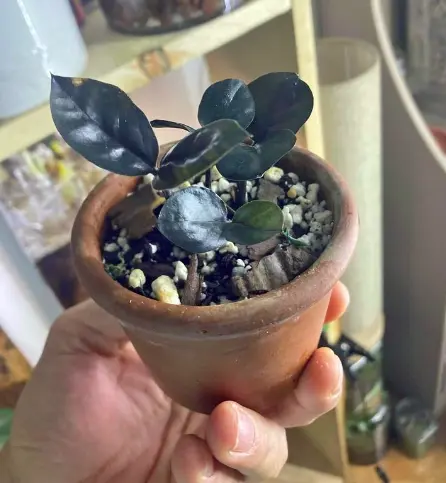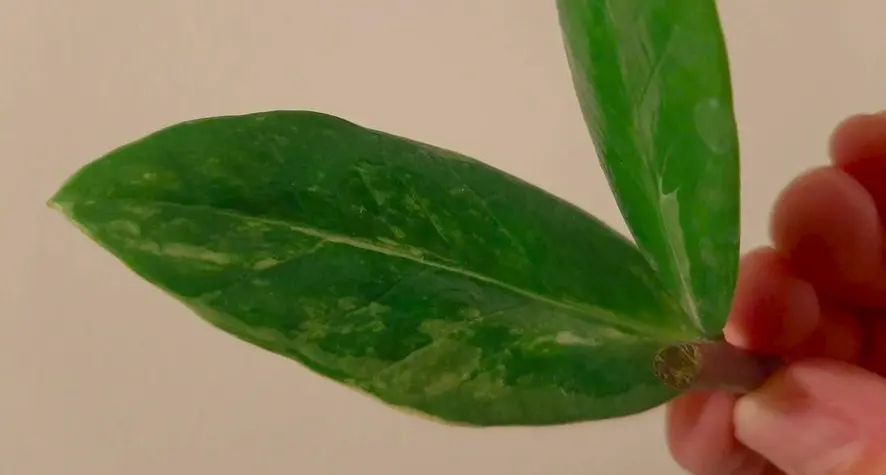A variegated ZZ plant is an easy-to-care-for houseplant perfect for adding color to your home or office. It’s known for its long-lasting, bright green variegation and ease of growth indoors and outdoors. That makes this plant unique and an eye-catcher in your home!
But this unique, tropical-looking plant does require more care than many other houseplants, and you should know how to grow it properly before bringing one home. This guide to growing and caring for the variegated ZZ plant will help you do that!
What is a Variegated ZZ Plant?

Zamioculcas zamiifolia, also known as the variegated ZZ plant, is an exotic-looking houseplant with long and slender leaves growing from a thick, woody stem. It is a succulent houseplant with leaves that mix green, white, and yellow shades. The plant doesn’t typically flower, but sometimes it will produce a small white or cream-colored blooming stalk.
Variegated ZZ plants grow up to two feet tall in the wild and can be as wide as four feet. You can keep these plants at an average household temperature between 60°F – 80°F during the day and 50°F – 60°F at night. If you want your ZZ plant to bloom more frequently, you’ll need to keep its environment warmer than 70°F regularly.
Where Does Variegated ZZ Plant Come From?
The variegated ZZ plant is native to the tropical forests of Central and South America but is originally from Kenya. The variegated ZZ plant is an aroid named after the plant species Zamia. This plant gets its unique markings from the environmental stresses in its natural habitats, such as light variation and low humidity. It typically grows 6-10 inches long by 3-6 inches wide but can get up to 16 inches long by 8 inches wide when grown outdoors on a tree or other support system.
The ZZ Plant Varieties
ZZ plant varieties differ in size, leaf color, height, and growth conditions. Among the most common varieties of ZZ plants are:
Dark Zamicro
The ‘Dark Zamicro,’ also known as Dwarf Black ZZ, is similar to Raven ZZ due to its glossy leaflets that appear practically black. The only distinctive feature between the two is their height (Raven ZZ stands 3 feet tall, while ‘Zamicro’ grows no more than 2 feet). Although the leaves of this ZZ cultivar are smaller than those of typical ZZs, they have the same medium-dark glossy look.
The Raven ZZ

The Raven ZZ is among the gorgeous houseplants available, and not just among ZZ plants. The leaves intense dark green color makes a powerful impression. This one, like the conventional variety, is easy to maintain. Furthermore, this variety is easy to get, as it is frequently seen in nurseries and plant stores.
Zenzi (The Dwarf ZZ)

Zenzi is a new ZZ cultivar recognized for its dwarf-growing characteristics, which makes it an ideal ornamental plant for compact settings. It is shorter than normal ZZ plants, standing at least one inch taller. Because of its dwarf status, its glossy leaflets cluster on the leaf stem, giving it a chunkier appearance. If grown indoors, it rarely produces flowers and contains heavy calcium oxalate crystals, making it toxic to pets and humans.
Zamioculcas zamiifolia (Variegata)
The Variegata, also known as Zamioculcas zamiifolia, is an aroid ZZ plant variety named after the plant species Zamia. The Araceae botanical family largely influences it. Its green-creamy golden glossy leaves are grouped and often spread outwards from its rhizomes, reaching 2-3 feet. It is drought tolerant, making it an ideal plant for conserving water.
ZZ Lucky Classic Plant
The Lucky Classic has slightly curved leaves, which set it apart from other ZZ plant species. The color is comparable to that of the regular type. The ZZ Lucky Classic Plant has slimmer, longer leaves than the other varieties.
Growing Variegated ZZ Plant
Variegated ZZ plants can be grown by stem cuttings, leaf cuttings, or dividing. However, dividing is the quickest and most effective approach to propagating this unique plant.
Method 1: Dividing
- Before dividing, start with a large, healthy plant at least 2-3 years old; otherwise, it may not withstand the impact when you start dividing.
- Divide the plant into sections using at least 2-5 stems each, depending on its size. Before you begin, count how many there are and prepare the appropriate fresh pots.
- Fill each pot halfway with perlite or coconut coir.
- When the pots are ready, carefully take the plant from the container and gradually loosen the roots to remove any extra dirt. Alternatively, you can rinse the rhizomes with water.
- After rinsing the plant, examine it to determine where it can be readily divided. You may need to separate the smaller roots with a utility knife and remove any dead or damaged plant material.
- Divide the plant into parts and put each in a clean, new pot with fresh soil mix.
- Water often and treat it as you would do to a mature plant.
Method 2: Stem Cuttings

- Begin by selecting a healthy-looking stem.
- Cut the plant at the root using a clean and sharp pair of secateurs. Because the stem will not regrow from the cut, trim it as near the earth as possible to keep the plant appearing clean.
- Remove the bottom leaves to allow enough stem to grow in water or soil.
- The next step is to determine whether to root your stem cutting in water or soil. To root the stem in water, lay the plant in a glass of water, ensuring the leaves are not buried, and wait for the roots to form. Change the water every week and top it up as needed.
- Plant your cuttings in a wet propagation medium containing equal perlite and coconut coir to root in the soil.
- Dig a few holes in the mix and insert the cuttings facing up. Before transplanting the plants, keep the soil moist until you observe new growth.
This strategy is useful for reducing plant transplant stress. The stem cutting will take weeks or months to root, so be patient.
Method 3: Leaf Cuttings
- Remove the plant’s healthy leaves, taking as many of the petiole as possible with you to ensure the leaf-cutting has the proper tissues to form roots.
- Fill a container or tray halfway with propagation medium (equal parts perlite and coconut coir) and position the leaves roughly a fourth up the leaf.
- Keep the tray moist and place it warmly for the roots to grow.
It may take several months, but when you gently tug on them and remain firm, it indicates that they have rooted and can be transferred to a new pot.
Caring for a Variegated ZZ Plant
The Variegated ZZ Plant is a beautiful houseplant that requires low maintenance as long as it gets enough sunlight. It thrives in an environment with a constant temperature of 65-85 degrees Fahrenheit. Taking care of a Variegated ZZ Plant can be done in the following ways:
- Place your plant in an area with indirect sunlight during the day, but ensure it is exposed to direct sunlight for at least four hours per day.
- You can add humidity by placing your pot next to a humidifier or near plants with thick leaves like ivy.
- Keep the soil moist, but never soggy wet. You’ll know if you have too much water because the soil will start to decompose and have a rotten smell. Letting your pot dry out between watering sessions is good because it lets you know when you need more water.
- Ensure the pot has plenty of drainage holes at the bottom so excess water can drain away easily without creating a puddle at the pot’s base.
- If your plant is performing poorly, repot it in the spring, it might be because the roots are clogged, or there need to be more nutrients within the soil for the plant to operate as effectively as possible. To avoid overstressing the plant, repot it only every 2-3 years.
Pests and Diseases of Variegated ZZ Plants
Pests that are known to attack the variegated ZZ plants include spider mites, mealybugs, scale insects, and whiteflies. Variegated ZZ plants are susceptible to fungal diseases such as brown spots, scales, and yellow leaves, and they can lose variegation if the plant suffers from any of these issues. Hence, ensure to keep the plant away from these pests, such as under furniture or near windows.
When it comes to variegated ZZ plant care, the most important thing is to be aware of their sensitive nature. They are susceptible to root rot, as well as overwatering. Variegated ZZ plants also need plenty of sunlight, so you’ll want them in a location with at least six hours of sun exposure per day. And because they’re more sensitive than other houseplants, ensure to keep your plants from moving around the house too often.
